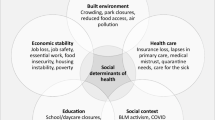Abstract
This chapter describes the development of the Neighbor to Neighbor Volunteer Corps (“N2N”) at a major New York City-based university in March, 2020, during the COVID-19 global pandemic. N2N is a civic engagement program to assist neighbors in university Faculty Housing with basic needs, mental health, and social isolation. The objectives of this chapter are to (a) explicate a conceptual framework within an historical context, along with important guiding values that helped to build the university’s capacity to respond to COVID-19; (b) identify at-risk populations among a heterogeneous population, acknowledging the diversity of residents in the neighborhood; (c) discuss programmatic elements of the project, specifically the ways in which the shared trauma of COVID-19 helped build resilience among the neighbors involved in the project; and (d) discuss how this intervention at the community level contributes to the larger knowledge base of macro-, mezzo-, and micro-discussions of productive aging and clinical social work practice.
Access this chapter
Tax calculation will be finalised at checkout
Purchases are for personal use only
Similar content being viewed by others
References
Arnold, D., Calhoun, L. G., Tedeschi, R., & Cann, A. (2005). Vicarious posttraumatic growth in psychotherapy. Journal of Humanistic Psychology, 45, 239–263.
Bellafante, G. (2020, March 14). The rich have a coronavirus cure: Escape from New York. Retrieved August 03, 2020, from https://www.nytimes.com/2020/03/14/nyregion/Coronavirus-nyc-rich-wealthy-residents.html.
Erikson, E. H. (1974). Dimensions of a new identity. New York: Norton.
Gonzales, E., Matz-Costa, C., & Morrow-Howell, N. (2015, April). Increasing opportunities for the productive engagement of older adults: A response to population aging. The Gerontologist, 55(2), 252–261.
Gonzales, E., Suntai, Z., & Abrams, J. (2019). Volunteering and Health outcomes among older adults. In D. Gu & M. Dupre (Eds.), Encyclopedia of gerontology and population aging. Cham: Springer.
Gonzales, E., Morrow-Howell, N., Angel, J., Fredman, L., Marchiondo, L. A., Harootyan, R., Choi, J., Choudhury, N., Carolan, K., Lee, K., Tan, E., Yu, P., Shea, E., & Matz, C.. (accepted). Integrating AASW&SW’s grand challenges of productive aging and health equity to guide efforts to improve the health of an aging population. In M. Teasley, M. Spencer & M. Bartholomew (Eds). Racism and the grand challenges for the social work profession. New York: Oxford University Press.
Gonzales, E., Gordon, S., Whetung, C., Connaught, G., Collazo, J., & Hinton, J.. (under review). Acknowledging structural discrimination in the context of a pandemic: Advancing an anti-racist, anti-sexist, and anti-ageist movement.
Gordon, S. (2020). Ageism and age discrimination in the family: Applying an intergenerational critical consciousness approach. Clinical Social Work Journal., 48, 169.
Morrow-Howell, N., & Gonzales, E. (2020). Recovering from COVID-19: Recommitting to a productive aging perspective. Public Policy & Aging Report, XX(X), 1–5.
Morrow-Howell, N., Hinterlong, J., & Sherraden, M. (Eds.). (2001). Productive aging: Concepts and controversies. Baltimore: John Hopkins University Press.
Nuttman-Shwartz, O. (2014). Shared resilience in a traumatic reality: A new concept for trauma workers exposed personally and professionally to collective disaster. Trauma, Violence, and Abuse, 1–10.
NYC Health. (2020, March 31). Coronavirus disease 2019 (COVID-19) daily data summary. NYC Health | City of New York. https://www1.nyc.gov/assets/doh/downloads/pdf/imm/covid-19-daily-data-summary-03312020-2.pdf
Slater, C. L. (2003). Generativity versus stagnation: An elaboration of Erikson’s adult stage of human development. Journal of Adult Development, 10(1), 53–65.
Tosone, C., Nuttman-Shwartz, O., & Stephens, T. (2012). Shared trauma: When the professional is personal. Clinical Social Work Journal, 40(2), 231–239.
Author information
Authors and Affiliations
Corresponding author
Editor information
Editors and Affiliations
Rights and permissions
Copyright information
© 2021 The Author(s), under exclusive license to Springer Nature Switzerland AG
About this chapter
Cite this chapter
Gordon, S., Gonzales, E., Hinton, J. (2021). Building the Capacity of Neighborhoods and the Resilience of Neighbors to Respond to COVID-19: The Neighbor to Neighbor Volunteer Corps. In: Tosone, C. (eds) Shared Trauma, Shared Resilience During a Pandemic. Essential Clinical Social Work Series. Springer, Cham. https://doi.org/10.1007/978-3-030-61442-3_22
Download citation
DOI: https://doi.org/10.1007/978-3-030-61442-3_22
Published:
Publisher Name: Springer, Cham
Print ISBN: 978-3-030-61441-6
Online ISBN: 978-3-030-61442-3
eBook Packages: Behavioral Science and PsychologyBehavioral Science and Psychology (R0)




